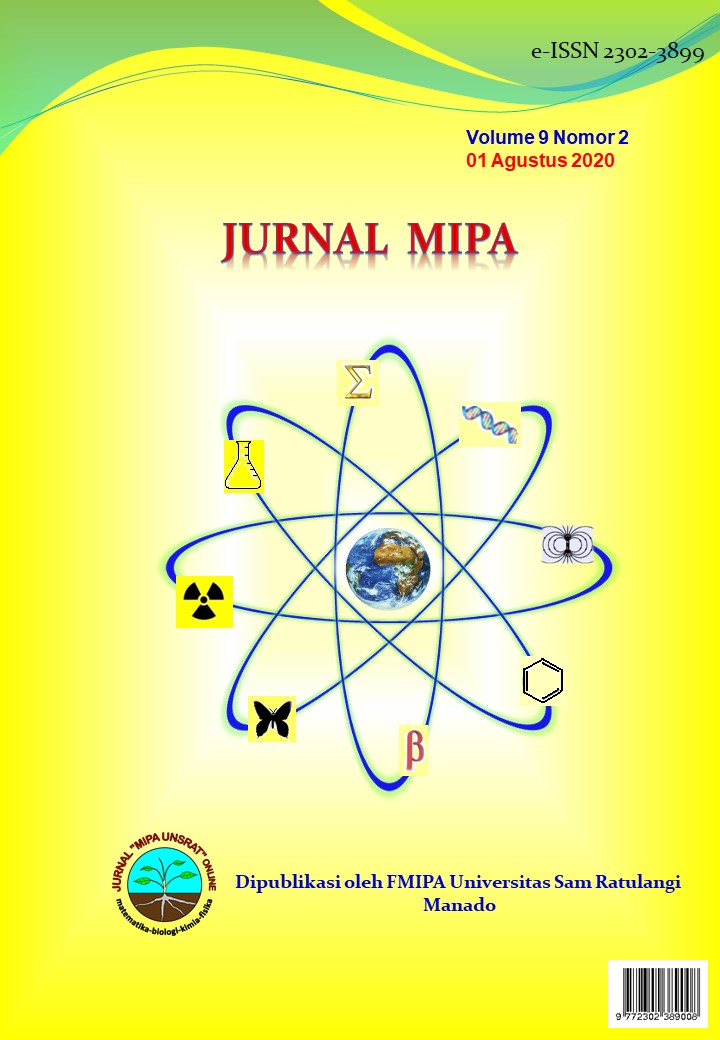Analisis Senyawa Tannin Dan Aktifitas Antibakteri Fraksi Buah Sirih (Piper betle L) Terhadap Streptococcus mutans
DOI:
https://doi.org/10.35799/jmuo.9.2.2020.28922Keywords:
Betel Fruit, Tannin Compounds Antibacterial, Streptococcus MutansAbstract
Kerusakan gigi salah satunya adalah karies gigi yang di sebabkan oleh bakteri Streptococcus mutans. Buah sirih (Piper betle L) dapat di gunakan untuk tanaman obat karena memiliki kandungan senyawa tanin sebagai antibakteri. Tujuan penelitian untuk mengetahui kandungan senyawa tanin dan uji aktifitas antibakteri fraksi n-heksan, kloroform dan etil asetat terhadap bakteri Streptococcus mutans. Jenis penelitian ini ialah Deskriptif Analitik. Pengujian kandungan senyawa tanin secara kualitatif ekstrak buah sirih menggunakan kromatografi lapis tipis (KLT) dan spektrofotometer Uv-Vis serta pengujian antibakteri pada konsentrasi 3%, 4%, 5% dan 6% untuk masing-masing fraksi. Hasil penelitian menunjukan bahwa ketiga fraksi: n-heksan, kloroform dan etil asetat positif mengandung senyawa tanin. Pengujian antibakteri pada konsentrasi 3%, 4%, 5% dan 6% menunjukan adanya aktifitas antibakteri dari ketiga fraksi : n-heksan ,kloroform dan etil asetat terhadap bakteri Streptococcus mutans dengan daya hambat berturut-turut untuk fraksi n-heksan 12.883±0.510; 12.600±1.455; 13.916±2.877; 13.550±3.347, untuk fraksi kloroform 16.400±1.646; 16.450±1.053; 17.183±1.830; 17.916±1.338 dan fraksi etil asetat 16.400±1.200; 16.000±0.327; 16.850±1.253; 17.450±1.297. Sehingga dapat disimpulkan ekstrak buah sirih mengandung senyawa tanin dan ketiga fraksi n-heksan ,kloroform dan etil asetat memiliki aktifitas antibakteri terhadap Streptococcus mutans dengan kategori kuat.
Tooth decay one of which is dental caries caused by Streptococcus mutans bacteria. Betel fruit (Piper betle L) can be used for medicinal plants because it contains tannin compounds as antibacterial. The purpose of this study was to determine the content of tannin compounds and test the antibacterial activity of the n-hexane, chloroform and ethyl acetate fractions against Streptococcus mutans. This type of research is Descriptive Analytic. Testing the content of tannin compounds qualitatively betel fruit extract using thin layer chromatography (TLC) and Uv-Vis spectrophotometer and antibacterial testing at concentrations of 3%, 4%, 5% and 6% for each fraction. The results showed that all three fractions: n-hexane, chloroform and ethyl acetate positively contained tannin compounds. Antibacterial testing at concentrations of 3%, 4%, 5% and 6% showed antibacterial activity of the three fractions: n-hexane, chloroform and ethyl acetate against Streptococcus mutans with inhibitions for the n-hexane fraction 12.883 ± 0.510; 12,600 ± 1,455; 13,916 ± 2,877; 13,550 ± 3,347, for the chloroform fraction 16,400 ± 1,646; 16,450 ± 1,053; 17,183 ± 1,830; 17,916 ± 1,338 and the ethyl acetate fraction 16,400 ± 1,200; 16,000 ± 0.327; 16,850 ± 1,253; 17,450 ± 1,297. So it can be concluded that betel fruit extract contains tannin compounds and the three fractions of n-hexane, chloroform and ethyl acetate have antibacterial activity against Streptococcus mutans with a strong category.






